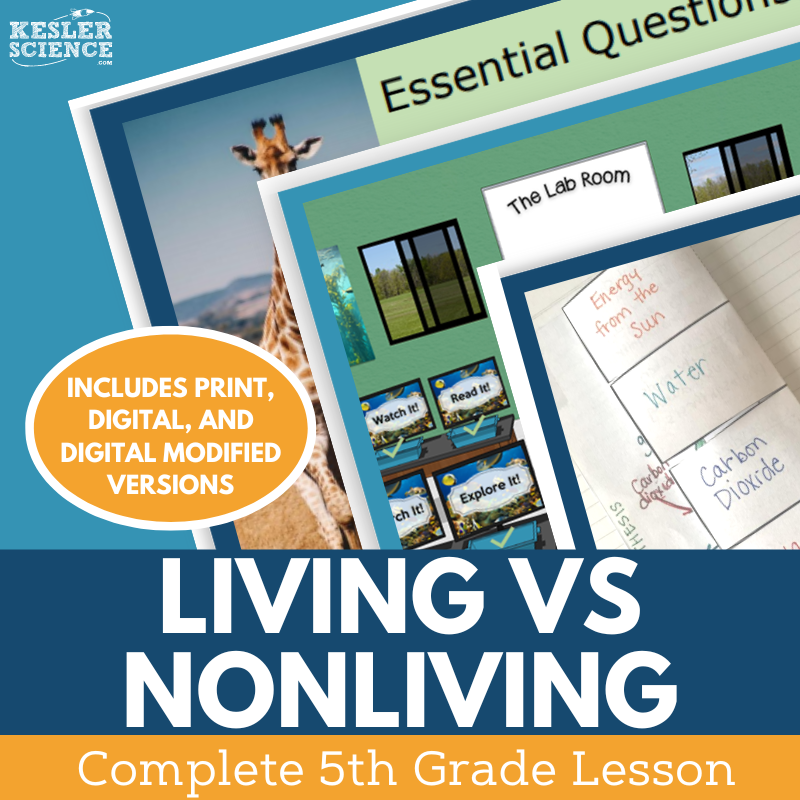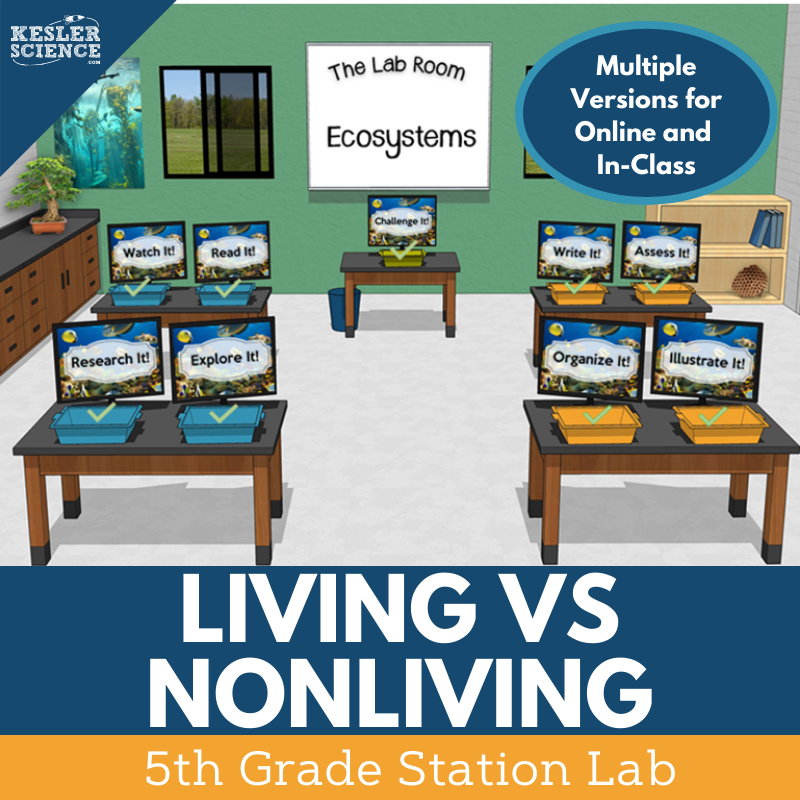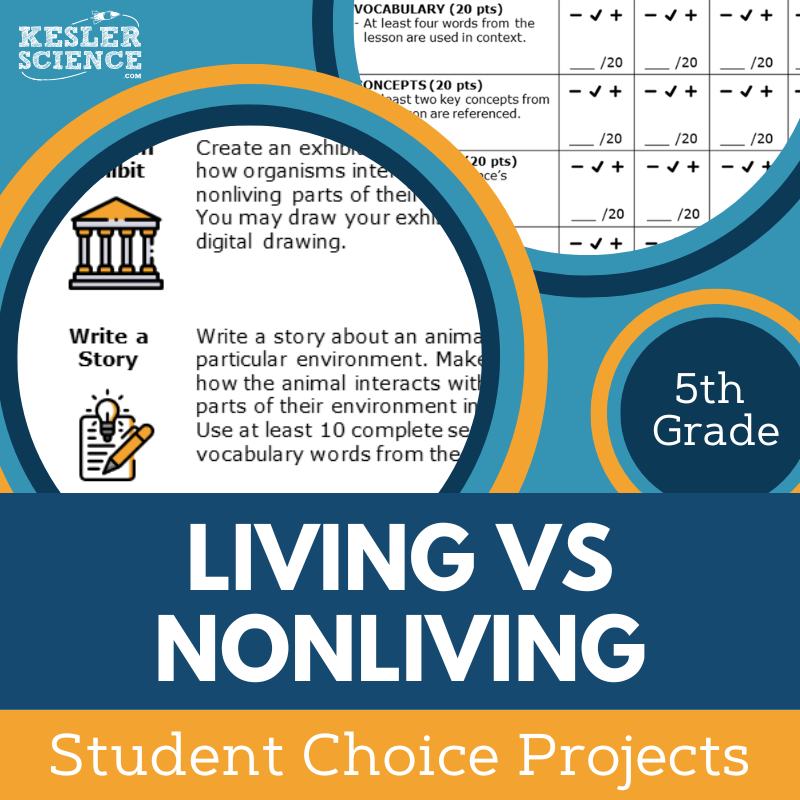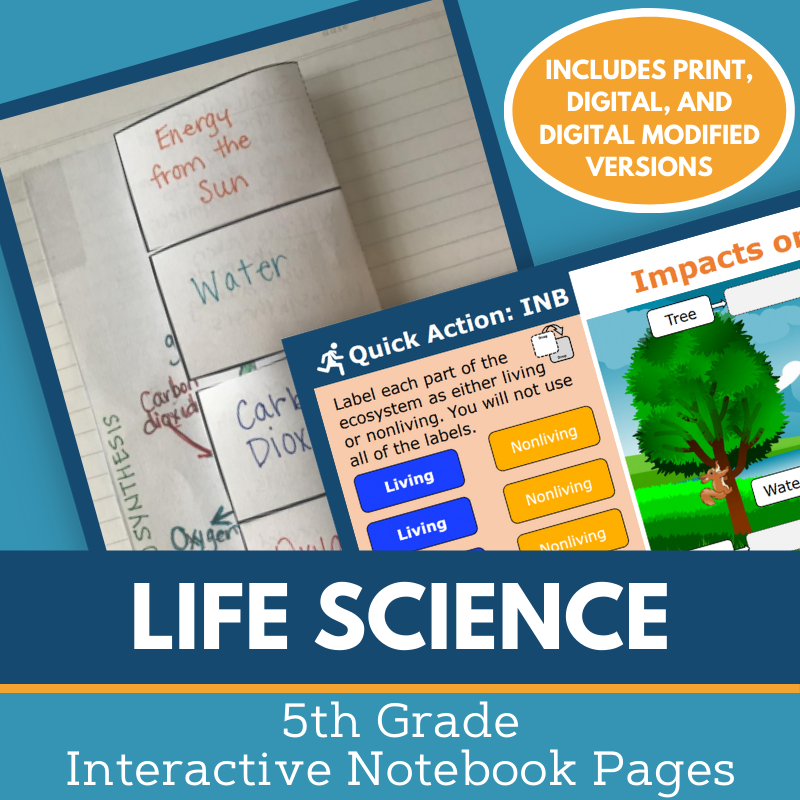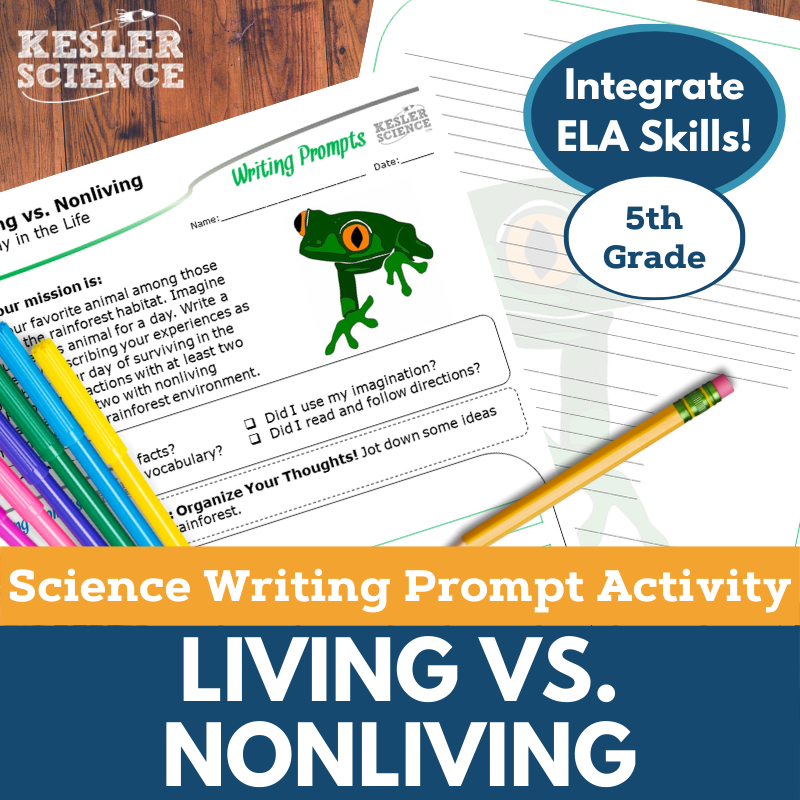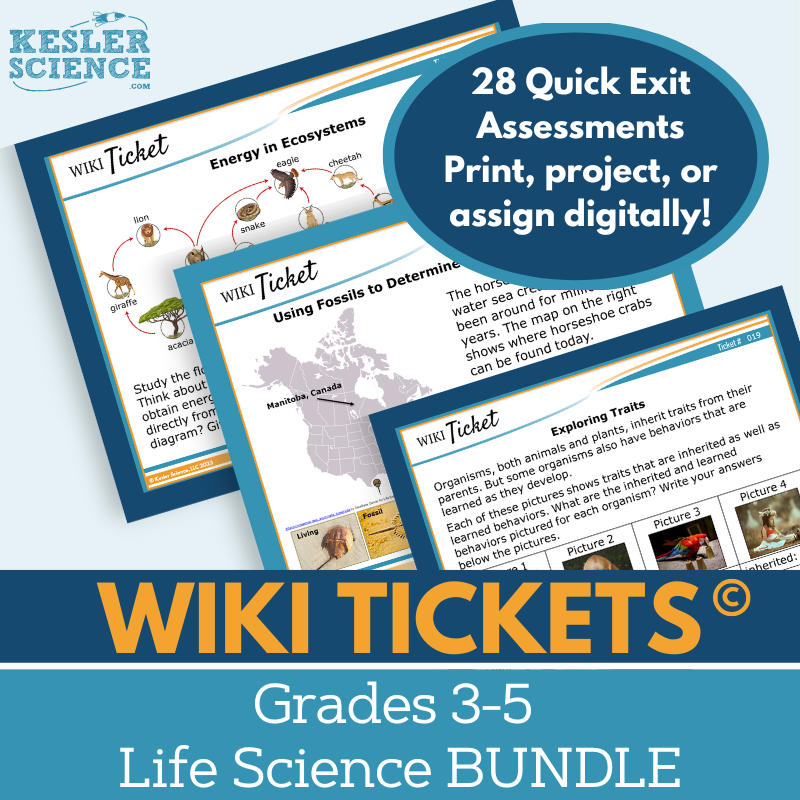Living vs Nonliving Activities for 5th Grade Science
The Kesler Science Living vs Nonliving resources are designed to engage 5th grade students in understanding the characteristics that define living and nonliving things. The resources below will give students a comprehensive understanding of the living and nonliving parts of an ecosystem. All of the following materials are also included in the Kesler Science Membership.
Transform your lesson planning into a breeze with the Kesler Science Living vs Nonliving 5th Grade Complete 5E Lesson. This comprehensive, student-centered lesson plan requires minimal prep and gives students the opportunity to take charge of their learning while focusing on real scientific concepts. Whether you’re teaching in person or remotely, this flexible and engaging resource supports diverse learning styles and ensures every student stays involved.
The lesson follows the 5E Model, covering key stages: Engagement, Exploration, Explanation, Elaboration, and Evaluation. Students will dive into essential questions like, “What are the living and nonliving parts of an ecosystem?” and “How do organisms depend on their environment for survival?” Differentiated activities such as the student-led station lab, interactive PowerPoints, and projects provide ample opportunities for exploration and deepening understanding.
This lesson includes editable resources, Spanish translations, and digital or printable formats to cater to every classroom need. With hands-on activities like card sorts, drawing, and writing prompts, students can demonstrate their knowledge in multiple ways. Additionally, the Challenge It! station offers early finishers opportunities to expand their learning while all materials are designed to work for both in-person and virtual settings.
Transform your lesson planning into a breeze with the Kesler Science Living vs Nonliving 5th Grade Complete 5E Lesson. This comprehensive, student-centered lesson plan requires minimal prep and gives students the opportunity to take charge of their learning while focusing on real scientific concepts. Whether you’re teaching in person or remotely, this flexible and engaging resource supports diverse learning styles and ensures every student stays involved.
The lesson follows the 5E Model, covering key stages: Engagement, Exploration, Explanation, Elaboration, and Evaluation. Students will dive into essential questions like, “What are the living and nonliving parts of an ecosystem?” and “How do organisms depend on their environment for survival?” Differentiated activities such as the student-led station lab, interactive PowerPoints, and projects provide ample opportunities for exploration and deepening understanding.
This lesson includes editable resources, Spanish translations, and digital or printable formats to cater to every classroom need. With hands-on activities like card sorts, drawing, and writing prompts, students can demonstrate their knowledge in multiple ways. Additionally, the Challenge It! station offers early finishers opportunities to expand their learning while all materials are designed to work for both in-person and virtual settings.
The Kesler Science Living vs Nonliving Station Lab provides 5th grade students with a modular, student-led learning experience, helping them identify and compare living and nonliving things. The nine stations include differentiated activities that cater to various learning styles, allowing students to direct their own learning while teachers facilitate. The lab offers a flexible, hands-on approach with minimal prep time required.
Each station includes materials such as signage, task cards, and resources for independent or small group work. Stations like Explore It! and Research It! allow students to engage with multimodal activities, while Output stations like Organize It!, Illustrate It!, and Write It! enable them to demonstrate their understanding in creative ways. A bonus Challenge It! station provides extension activities for early finishers.
The station lab is designed for both in-person and virtual learning, using accessible classroom materials. It is also equipped with differentiated resources, including Spanish translations, and a challenge station for students needing extra stimulation. The modular structure and flexible format make it easy for teachers to adapt the lab to suit their classroom needs.
The Kesler Science Living vs Nonliving Station Lab provides 5th grade students with a modular, student-led learning experience, helping them identify and compare living and nonliving things. The nine stations include differentiated activities that cater to various learning styles, allowing students to direct their own learning while teachers facilitate. The lab offers a flexible, hands-on approach with minimal prep time required.
Each station includes materials such as signage, task cards, and resources for independent or small group work. Stations like Explore It! and Research It! allow students to engage with multimodal activities, while Output stations like Organize It!, Illustrate It!, and Write It! enable them to demonstrate their understanding in creative ways. A bonus Challenge It! station provides extension activities for early finishers.
The station lab is designed for both in-person and virtual learning, using accessible classroom materials. It is also equipped with differentiated resources, including Spanish translations, and a challenge station for students needing extra stimulation. The modular structure and flexible format make it easy for teachers to adapt the lab to suit their classroom needs.
The Kesler Science Living vs Nonliving Student Choice Projects provide 5th grade students with a variety of project options to match their preferred output styles. Students can choose from six different projects or create their own, with the option to be assessed by teachers, peers, or themselves using a flexible grading rubric. These dynamic projects offer creative ways for students to demonstrate their understanding of living and nonliving concepts.
The project choice board includes nine options, plus a “design your own” project. Teacher Directions and editable rubric pages help guide and assess vocabulary, concepts, and presentation. The materials are differentiated to support all learners, with modified options for remediation and advanced choices for students needing more challenge.
The projects use standard classroom materials, such as paper and markers, with many options available for digital completion. For those interested in hands-on activities, crafting supplies may be useful for building models. Teachers can adapt the rubric to fit their grading needs and customize the projects for their classroom.
The Kesler Science Living vs Nonliving Student Choice Projects provide 5th grade students with a variety of project options to match their preferred output styles. Students can choose from six different projects or create their own, with the option to be assessed by teachers, peers, or themselves using a flexible grading rubric. These dynamic projects offer creative ways for students to demonstrate their understanding of living and nonliving concepts.
The project choice board includes nine options, plus a “design your own” project. Teacher Directions and editable rubric pages help guide and assess vocabulary, concepts, and presentation. The materials are differentiated to support all learners, with modified options for remediation and advanced choices for students needing more challenge.
The projects use standard classroom materials, such as paper and markers, with many options available for digital completion. For those interested in hands-on activities, crafting supplies may be useful for building models. Teachers can adapt the rubric to fit their grading needs and customize the projects for their classroom.
The Kesler Science 5th Grade Life Science Interactive Notebook Bundle provides engaging, hands-on learning for key life science topics. This comprehensive resource includes both print and digital versions, making it perfect for traditional classrooms, 1:1 environments, and distance learning.
The digital interactive notebook features a unique PowerPoint format, Google Slides compatibility, reflection pages, space for notes, and a modified version for students with accommodations. The paper version includes blank and pre-filled templates, plus color photo examples for easy implementation.
Covering topics like plant growth, ecosystems, fossil evidence, and inherited traits, this bundle helps students organize their learning while giving teachers flexible, high-quality materials to enhance instruction.
The Kesler Science 5th Grade Life Science Interactive Notebook Bundle provides engaging, hands-on learning for key life science topics. This comprehensive resource includes both print and digital versions, making it perfect for traditional classrooms, 1:1 environments, and distance learning.
The digital interactive notebook features a unique PowerPoint format, Google Slides compatibility, reflection pages, space for notes, and a modified version for students with accommodations. The paper version includes blank and pre-filled templates, plus color photo examples for easy implementation.
Covering topics like plant growth, ecosystems, fossil evidence, and inherited traits, this bundle helps students organize their learning while giving teachers flexible, high-quality materials to enhance instruction.
The Kesler Science Living vs Nonliving Science and ELA Integrated Writing Activity gives 5th grade students an opportunity to deepen their understanding of living and nonliving things by exploring the daily needs of animals. Through a "Day in the Life" prompt, students will engage in fun and thoughtful writing exercises while strengthening their scientific reasoning. The activity is perfect for virtual learning, keeping students involved and learning even outside of the classroom.
This resource includes a variety of materials to support both teachers and students. Teacher directions, rubrics, and project ideas are provided, along with full-sized and half-sheet handouts. For digital learners, the PowerPoint version can be saved as Google Slides and assigned to students for easy editing and completion.
Flexible and creative, the Kesler Science Living vs Nonliving Writing Activity is ideal for differentiation, formative assessments, and student projects. It can be used in various scenarios like pre-test activities, elaboration for early finishers, extra credit, or make-up work. The activity promotes cross-curricular learning, helping students strengthen both their science and writing skills.
The Kesler Science Living vs Nonliving Science and ELA Integrated Writing Activity gives 5th grade students an opportunity to deepen their understanding of living and nonliving things by exploring the daily needs of animals. Through a "Day in the Life" prompt, students will engage in fun and thoughtful writing exercises while strengthening their scientific reasoning. The activity is perfect for virtual learning, keeping students involved and learning even outside of the classroom.
This resource includes a variety of materials to support both teachers and students. Teacher directions, rubrics, and project ideas are provided, along with full-sized and half-sheet handouts. For digital learners, the PowerPoint version can be saved as Google Slides and assigned to students for easy editing and completion.
Flexible and creative, the Kesler Science Living vs Nonliving Writing Activity is ideal for differentiation, formative assessments, and student projects. It can be used in various scenarios like pre-test activities, elaboration for early finishers, extra credit, or make-up work. The activity promotes cross-curricular learning, helping students strengthen both their science and writing skills.
The Kesler Science Life Science WIKI Tickets offer fun and engaging formative assessments for 3rd–5th grade students. With 28 topics aligned to NGSS and TEKS standards, these exit tickets cover essential life science concepts such as ecosystems, traits, life cycles, and energy flow.
Each WIKI Ticket comes in multiple formats, including a projectable display, three printable handout sizes, and a digital version for PowerPoint or Google Slides. This flexibility makes them perfect for quick checks of student understanding, whether in-person or virtual.
Use WIKI Tickets as exit tickets, bellringers, or anytime you need to assess student learning. Their colorful, interactive design helps keep students engaged while providing valuable insights into their progress.
The Kesler Science Life Science WIKI Tickets offer fun and engaging formative assessments for 3rd–5th grade students. With 28 topics aligned to NGSS and TEKS standards, these exit tickets cover essential life science concepts such as ecosystems, traits, life cycles, and energy flow.
Each WIKI Ticket comes in multiple formats, including a projectable display, three printable handout sizes, and a digital version for PowerPoint or Google Slides. This flexibility makes them perfect for quick checks of student understanding, whether in-person or virtual.
Use WIKI Tickets as exit tickets, bellringers, or anytime you need to assess student learning. Their colorful, interactive design helps keep students engaged while providing valuable insights into their progress.
Year-Round Resources
These year-round activities will increase your students' understanding of many middle school science topics. All of these activities are also included in the Kesler Science Membership.
Visual Data & Graphing
You're not alone if your students struggle with understanding graphs, charts, and tables. It's a skill that takes an enormous amount of practice. This resource will help students build a strong foundation in analyzing data and creating their own data visualizations.
Bell Ringers and Warm-Ups
These middle school science bell ringers are an excellent way to engage your students as soon as they walk into your classroom. This comprehensive FULL YEAR resource includes everything you need to start off each science class with an interesting warm-up activity.
Review Board Games
Each game board has been carefully designed to keep students engaged. There are 10 different action spaces on each board and dozens of question cards. All of the actions are related to science concepts and keep the students motivated throughout the game.
Each game is ready to play. Simply print out the board and the cards and let the students enjoy reviewing nine different units.
Essential Questions
Below are the essential questions associated with the lessons and activities included in this unit. This topic is only one of more than 100 middle school science topics included in the Kesler Science Membership.
-
What are the living and nonliving parts of an ecosystem?
-
How do organisms depend on their environment for survival?
Kesler Science Membership
Imagine never having to search for another middle school science lesson again. The membership gives you access to ALL of the Kesler Science products in one place (Yes, including everything above).
Say goodbye to long hours of lesson prep.

